4.1 Rules of the Road
It is as important to have rules for vessels at sea to follow as it is on the roads. In any situation, you need to know what you are 'supposed to do', and indeed what the other vessel expects you to do. If you do something different, you will confuse him with possibly dangerous consequences.
This is why you need to have a 'working knowledge' of the rules of the road, even if you don't know every single rule. It's no use just deciding to keep out of everyone's way, or keep out of the way of bigger vessels, because in certain situations the correct action is to keep you course and speed, and this is what the other vessel will expect you to do!
I remember overhearing a conversation on the VHF between a large oil tanker and a small sailing yacht. The yacht had evidently decided to alter course to 'keep out of the way' just as the tanker was itself altering course. The skipper of the tanker had quite a lot to say about it, along the lines of: "That was a very interesting manoeuvre sir, could you tell us why you did that? We were altering course to go behind you, and you turned straight into our path .... " etc. You can imagine that it's not easy being on the bridge of a large ship if a small vessel takes an unexpected action, so the moral is, know the rules and follow them.
In this section, we explain the rules in (hopefully) a logical manner and order, and include references to the IRPCS rule numbers so that you can look up the definitive rule. Our objective is for you to understand the rule - how you apply it in practice is something that you will learn on a practical course.
The rules are founded on common sense and good seamanship. Frequently they state that if you are unsure about a particular situation, then you should err on the side of caution. (Examples are: if you are unsure whether you are technically the overtaking vessel, assume that you are; and if you are not sure whether a collision risk exists, assume that it does.)
Keep a Good Lookout (RULE 5) & Don't Go Too Fast (RULE 6)
The rules and the RYA's notes have quite a lot of additional detail and good advice on this, but essentially these two rules are common sense.
You are not going to spot potential collision situations unless you keep a good lookout all around you. Encourage your crew to do this, and make sure someone can see under or round any large headsails that might be in the way.
Similarly if you are going too fast (particularly when sailing or motoring in or near a harbour) it is obviously dangerous. Remember, other vessels may turn unexpectedly - they may be concentrating on finding a mooring, or they may just be incompetent!
How to Tell if there's a Risk of Collision (RULE 7)
If you are keeping a good lookout you will see other vessels, and you can then tell if the risk of collision exists by observing them. If they remain at a constant bearing to you as the distance between you closes, then you are on a collision course.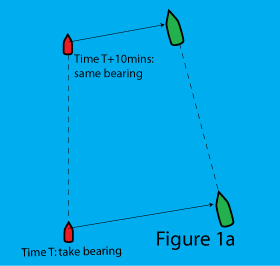
In practice you make a quick visual check, observing for example whether they are moving to the right or left against the land in the distance behind them, or whether they stay lined up on a particular part of your own boat (you must keep a constant heading for the second method to work).
The best way is to observe them over a period of time with the hand-bearing compass, and if the bearing doesn't change then a collision risk "is deemed to exist", and you then have to assess what you are required to do under the rules. 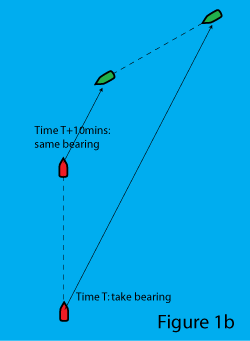
This is a clever rule of geommetry - see Figure 1 - and it works even if you can't tell how fast or in what direction the other vessel is moving, provided both vessels hold a constant course and speed.
What to Do Next
In most situations where a collision risk exists, the rules define that one of the vessels "shall keep out of the way" of the other. In these cases the one that is obliged to keep out of the way is referred to as the give-way vessel. The other is referred to as the stand-on vessel. Both vessels have obligations under the rules.
Action by Give-Way Vessel (RULE 8, RULE 16)
If you are the give-way vessel, you need to alter your course and/or speed to keep out of the way of the other vessel. There are some additional considerations:
• the action you take must be taken early, to keep the risk of collision (or confusion) to a minimum
• it needs to be positive and obvious , so the other vessel can see what you are doing (small changes will not be apparent to them)
• it also needs to be substantial, both to make it obvious, and also to keep a safe distance between the two vessels.
Clearly you need to consider any other vessels in the area and the safety of your own vessel (sea conditions, dangers) and all of this makes early, positive action sensible - if you leave it too late, you limit your options and may get dangerously close to a collision situation.
Normally you alter course to go behind the other vessel, which is obviously safer and gives you more control over the distance between the vessels.
Action by Stand-On Vessel (RULE 17)
If you are the stand-on vessel, and the other vessel has to keep out of your way, you might think you can relax, but it isn't quite that easy! For a start, you don't know if he has spotted the collision risk, or what he is going to do about it. You need to make it easy for him to avoid you, but ultimately it is still your responsibility to avoid the collision. For these reasons the rules specify what action you should take, and they are slightly more complex than the rules for giving way:
1. Hold your course and speed.
This is a requirement under the rule, and makes it easier for the other vessel to avoid you.
2. You may take action to avoid collision if ...
If it becomes apparent that the other vessel is not taking the appropriate action for a give-way vessel under the rules. In other words, you don't have to hold on until there is a serious risk of collision; he should have taken early and substantial action under the rules, and you have the option to do something if he doesn't.
You have to be careful here, though. You might be in trouble if he simultaneously alters course to avoid you, so you need to do something that will avoid the collision if that happens (e.g. tack, and head away from him). Plan this in advance.
3. You shall take action to avoid collision if ...
If collision cannot be avoided by the action of the other vessel alone. This is another requirement: ultimately it is both vessels' responsibility to avoid the collision.
The Collision Risk Situations
Having decided whether a collision risk exists, and knowing what to do if you are the give-way or stand-on vessel, all we need to know now is: which vessel is the give-way and which the stand-on, in the various possible situations where a collsion risk exists.
Overtaking (RULE 13)
Any vessel overtaking another is required to keep out of the other's way until she is well clear. This applies even if you would 'normally' be the stand-on vessel, e.g. if you are sailing past a power-driven vessel. 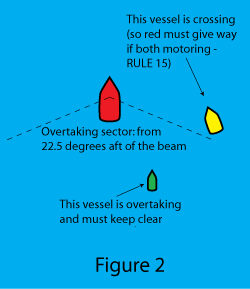
Overtaking is defined as coming up to another vessel from a direction as shown in Figure 2. In the diagram the green vessel is overtaking the red, but the yellow vessel is not.
Incidentally, this does not give the overtaken vessel the right to turn in front of the overtaking vessel: it would be poor seamanship to do that. You need to check, before altering course, whether there is any other vessel overtaking you.
Two Sailing Vessels (RULE 12)
Two sailing vessels decide which one is the give-way vessel on the basis of which tack they are on. (Provided neither is motoring, in which case she is a power-driven vessel.)
A vessel on port tack (i.e. with the wind on the port side and sails set on the starboard side) must give way to a vessel on the starboard tack. If both vessels are on the same tack, the windward vessel gives way. 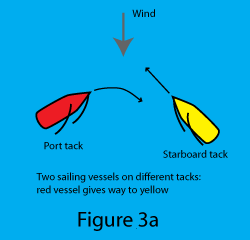
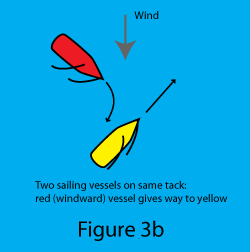
Figures 3a and 3b illustrate these situations.
Power-Driven Vessels: Head-On (RULE 14)
Two power-driven vessels approaching each other head-on (or very nearly head-on) should each alter course to starboard, and pass one another port-to-port. Figure 4 illustrates.
Note that this is consistent with the rule for narrow channels (see below).
Power-Driven Vessels: Crossing (RULE 15)
The more general case is when two power-driven vessels are crossing each other. In this case, the vessel which has the other on her starboard side must give way. Figure 5 illustrates this. 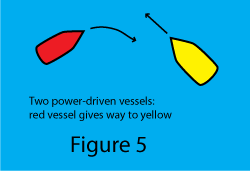
The rules effectively define three sectors around you (illustrated in Figure 6). If the other vessel is your the port sector, you are the stand-on vessel. If the other vessel is in your starboard sector, you are the give-way vessel.
 If the other vessel is approaching you in your astern sector, it is overtaking, so you stand on (and if you are approaching in his astern sector, you keep clear - see Overtaking, above).
If the other vessel is approaching you in your astern sector, it is overtaking, so you stand on (and if you are approaching in his astern sector, you keep clear - see Overtaking, above).
Remember: sailing yachts are power-driven vessels when they are motoring or motor-sailing.
Responsibilities Between Vessels of Different Types (RULE 18, RULE 3)
The rules establish a sort of "pecking order" between different types of vessel when they are underway (i.e not moored, anchored or aground), according to their manoeuvrability. The types of vessel (defined in RULE 3) are:
a) power-driven vessel (any size, but not constrained by draught)
b) sailing vessel (not using her motor)
c) vessel engaged in fishing: this means actually fishing, not just a fishing boat going home for tea (although I wonder if some of them know that...)
d) vessel constrained by draught: this means severly restricted in the course she can follow because of the available depth of water
e) vessel restricted in her ability to manoeuvre: this means restricted by the nature of her work, which includes underwater operations, dredging, surveying, towing etc.
f) vessel not under command: this means unable to manoeuvre because of some exceptional circumstance, e.g. steering or engine failure.
As logic would suggest, each type of vessel in the list should keep out of the way of the ones beneath it. This is where the old adage "power gives way to sail" comes from, but you can see that there are four classes of power-driven vessel that do NOT give way to sail, and sailing yachts need to know this and give way to them.
This raises the logical question of how you know that a vessel is engaged in fishing, constrained by draught, restricted in her ability to manoeuvre or not under command. The answer is that they are obliged to show certain lights and shapes, and these are dealt with in section 4.
Narrow Channels (RULE 9) 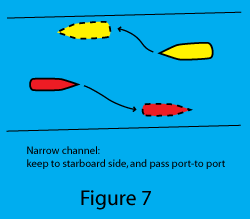
The main rule is "keep to the starboard side", passing on-coming traffic port-to-port.
See Figure 7. Small vessels and sailing vessels must not impede vessels that can only navigate within the channel.
For the yachtsman in practice, there are two types of "narrow channel": ones that we have to follow because of our draught (and therefore probably not navigated by ships) and ones that are defined for the purpose of large ships. In the former type, we keep as close as possible to the starboard side and exercise extreme care when overtaking. In the latter type we keep out of the way, and possibly out of the channel altogether if we can, particularly if it is busy.
Traffic Separation Schemes (RULE 10) 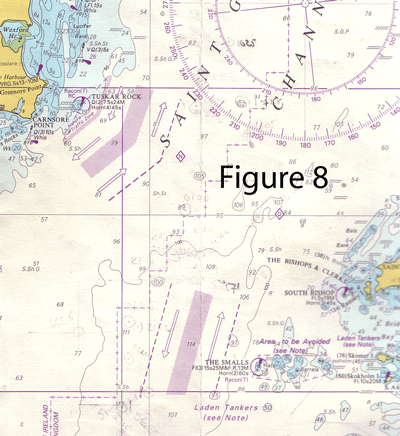
Traffic Separation Schemes are defined areas (marked on the chart - see Figure 8) where shipping traffic is directed to follow traffic lanes, which help to keep opposing traffic safely separated. They are relatively small areas in particularly busy spots (Dover Straits, Land's End), usually quite close to the coast.
Small craft and yachts are advised to keep away from traffic separation schemes. If obliged to cross one, we should do so as nearly at right angles to the traffic flow as possible, and not impede the passage of vessels using the traffic lanes.
Restricted Visibility (RULE 19)
For obvious reasons, the above rules are for vessels in sight of one another and most of them would be extremely difficult to apply if you can't see the other vessel.
The main instruction in the rules is to reduce speed, and be ready to take immediate manoeuvres to avoid collision in a close quarters situation.
Boats with radar and trained operators will be using those, and their use is outside our current scope. The best advice to avoid being run down is:
• use a radar reflector
• keep a good lookout by sight and sound
• be ready to take immediate and drastic avoiding action
• keep clear of shipping channels.
